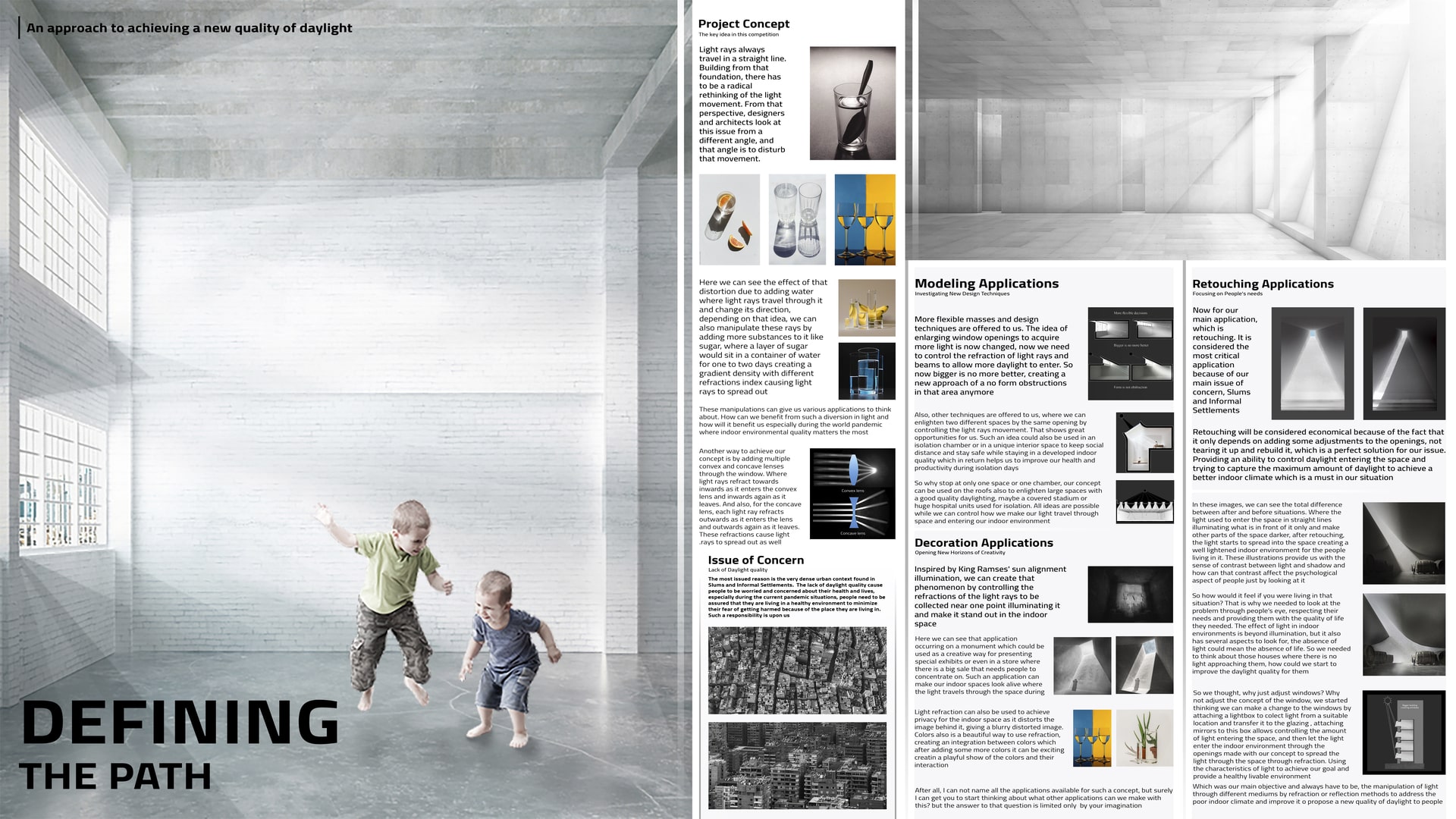Project Description
I. ISSUE OF CONCERN Lack of daylight in buildings is a significant issue that has numerous effects on our daily life. There are different reasons for such a problem, poor orientation, vertical cities expansion, dark environment, but the most prominent issue is the very dense urban context, as in the slums and informal settlements. The apparent low quality of light in such regions causes a poor indoor climate that is not suitable for daily life needs and has a negative impact on public's life and health. Those concerns are most relevant especially during this current pandemic. People need to be assured that they are living in a healthy environment to decrease their chances of getting harmed. As designers have a great obligation of responsibility to investigate, solve, and create new ways of defining light, that leads to a healthier lives. II. PROJECT DESCRIPTION From this point on, our team started to think about the main source of daylight in buildings, windows, and creating an opening that transfer daylight from outside to indoor environment. The transfer of light between two mediums is the genesis of the concept. Light beams and rays do travel in a straight line. Building from that foundation, there has to be a radical rethinking of the light movement. From that perspective, designers and architects look at this issue from a different angle, and that is to disturb the light movement. The fundamental question that is being asked here, "what would happen if there is an interruption to the light's path?" the answer is very simple and practical. By adding a different substance or object which has a different refractive indexes, between the two mediums, causes the light beams to refract in different directions creating a more comprehensive range of light rays traveling through the indoor environment, offering a new quality of daylight by increasing it's quantity trying to achieve the maximum amount of daylight in the space, by manipulating the refractive index which is the key idea in this competition. This concept can be achieved by different methods. One of the methods is adding a substance between the two mediums, by using water and sugar, added to the mixture to create a layer between the two glass panels in the window, making the window act as a sealed water tank. A layer of sugar would sit in a container of water for 24 to 48 hours. After that duration has passed, the sugar would have been dissolved but uneventfully, creating different levels of saturation. The different densities that are created throughout the solution are the critical idea for creating a gradient refractive index throughout this layer. The second approach to this concept, is by adding multiple objects of convex and concave lenses to the window where light rays can travel. Each light ray travels through a convex lens refracts inwards as it enters the lens and inwards again as it leaves. These refractions cause light rays to spread throughout the space. For the concave lens, each light ray entering the lens refracts outwards as it enters the lens and outwards again as it leaves. These refractions cause light rays to spread in a uniform way. By achieving those concepts mentioned above, many applications could be derived to acquire more quantity and better quality of daylight in buildings, thus, improving people's lives and health. III. APPLICATIONS i. Retouching This concept is economical by making small adjustments to the windows or openings, and that is suitable for slums and informal settlements. For poorly oriented houses, where daylight does not reach, a model of a lightbox could be attached to the windows to collect light from a suitable location and transfer it to the glazing. Adding mirrors to the lightbox allows controlling the amount of light that is entering the space. ii. Modeling New design techniques and more flexible masses are most suitable for these kinds of applications. Indoor environmental quality could be improved in hotter climates by adding a layer of water, which works as a "Trombe wall" to increase the time lag for heat that enters into the space. iii. Decoration Many applications in this area can be achieved. Inspired from the alignment of the sun on King Ramses II's face. This phenomenon can be created by the manipulation of the refractive index. It can define the path of the light to be concentrated at a specific region in the indoor space. Privacy can also be achieved by making the light refractions distort the sight of what is behind the window, or even add colors to it creating a playful show of colors interaction created by the light refractions. There are endless possibilities that can be imagined from this concept.
